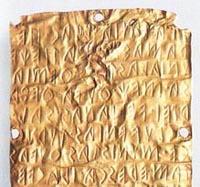- Introduction
- Further information

Etruscan is the oldest writing system among those of the pre-Roman populations of the Italian peninsula. The history of its development is directly connected to the birth of western alphabetic writing systems, codified beginning from the Phoenician model with Greek mediation.
In reality, it can be said that writing came to Italy together with the Greek colonists who brought the alphabet with them as soon as they arrived on Italian soil in the first half of 8th century BC. From Pithekoussai and then from Cumae in Campania, writing rapidly spread among the Etruscans – earliest Italian commercial partners of the Greeks – through direct contact among groups of aristocratic Etruscan and the élite of the colonials.
The alphabet arrived in Etruria together with the ideology of the symposium and with the cultural and artistic ferment coming from the Near East, making writing the most characteristic phenomenon of the so-called Orientalizing Period.
The Euboean-Chalcidian variant of the Greek alphabet in use among the earliest colonists to Campania was at first adopted in its entirety by the Etruscans, including even the letters of the Phoenician alphabet which Greek writing did not use, as well as those letters which were not necessary to the transcription of the Etruscan language. In fact it can be said that until the first half of 6th century BC the writing systems in Italy (Greek, Latin, Etruscan and Italic) all made use of the same alphabetic model, well exemplified on the Marsiliana d’Albegna tablet.
The needs of the Etruscan language, different from those of Greek, lead to a selection of the signs to be used which excluded the voiced plosives (beta and delta) and the vowel /o/. The gamma, instead, was used in writing as an alternative to kappa and qoppa to indicate the voiceless velar plosive /k/.
In a second period, the existence of two different sibilants (pronounced as the /s/ in “seed” and the /sh/ in “shock”) made the use of the Phoenician symbol tsade necessary, as opposed to the sigma.
To note down the fricative labialdental /f/, absent in Greek writing, at first the digraph vh or hv was used, until a new sign, which looked like an 8, was introduced.
The alphabet which Etruscan writing used, with the symbols unused in writing removed in mid 6th century, was roughly the following:
a c e v z h θ i k l m n p ś r s t u χ φ f
But in reality, different writing systems were adopted in the different regions of Etruria: for example in the northern area the kappa was used for the voiceless velar /k/, the tsade indicated the simple /s/ and the sigma the marked one /š/. South of Vulci and Orvieto, instead, the sibilants were inverted (sigma for /s/ and tsade for /š/) and, after a period of coexistence of c - k - q, the gamma alone was preferred. Lastly, only in Caere (Cerveteri), which belonged to the southern group, was the tsade substituted by a sigma formed by four segments.
As time went on, the evolution of Etruscan writing required the introduction of new variants of symbols (for example, the theta with an empty circle or with a crossed circle, the disappearance of the lower extension of some letters or the curved form of the oblique lines), without overly modifying the alphabetic sequence and without overturning the writing system.
From the point of view of the language, the so-called late Etruscan, from 5th century BC onwards, differentiates from early Etruscan for the phenomenon of the syncope, due to which the pronunciation of vowels after accents is weakened to the extent that they are not transcribed. This gives rise to written forms like Menrva instead of Menerva (name of a goddess) or turce in the place of turuce (verb for offerings).
Go to the online resources.
Online resourcesPhoto Gallery
List of symbols
Examples of writing
Bibliography
Map of places
